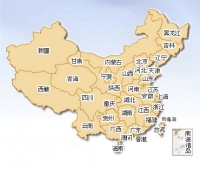| China Capital:peking Country Code: cn |
|
中国(汉语拼音:Zhōngguó)位于亚洲东部,传统意义上和现代地理概念上涵盖大中华地区。中国,又以“华夏”、“中华”、“中夏”、“诸夏”、“诸华”、“神州”等的代称出现。“华”、“夏”二字起源不明;“夏”,在商、周以前有夏朝;“华”,有说来自于古华胥国;也有说上古华、夏同音,本一字;同“花”,鲜花盛开的地方。《左传》是现存最早出现华夏二字并称的文献,其中有“裔不谋夏,夷不乱华”之言;按《说文》中的释义,“华,荣”,“夏,中国之人”。《左传·定公十年》疏云:“中国有礼仪之大,故称夏;有章服之美,谓之华。” ,《尚书正义》注“华夏”:“冕服华章曰华,大国曰夏。”;按照这里的说法,华是指华服,夏指有礼仪的大国,而“华夏”的意思就是“身穿华服的礼仪之邦 ”。而汉语“中国”一词,最早指天下(中国人观念中的世界)的“中心”——中原地带,后逐渐带有王朝统治正统性的意义。近代以来,“中国”一词作官方正式称呼始于清朝。中华民国是第一个以“中国”为国号的国家,但在中国共产党击败中国国民党并统治中国大陆后,现在一般特指中华人民共和国。
在地理上,中国的版图由两个不同国号的国家即中华人民共和国和中华民国控制之领土组成,而中华人民共和国占据了大部分,故现在中国一般指中华人民共和国,而中华民国领土往往简称为台湾或台澎金马。居于中国疆域内的各个民族统称为中华民族,亦称“华人”,移居境外的华人多被称为“海外华人”,或自称“华族”。汉族是中国人口最多,地域分布最广的民族。在少数民族当中,人口过500百万(2000年人口普查)的有壮、满、回、苗、维吾尔、彝、土家、蒙古和藏等9大民族,通用汉语,少数民族地区往往使用各民族自己的语言。中国人普遍喜好书法、国画、戏曲、象棋、围棋和武术等,茶、酒、菜和筷子等为中国的特色饮食文化,中国新年、中秋、清明、端午等为传统节日。中国传统上是一个儒学思维国家。中国人有强烈的家庭观念,因此将代表家庭的姓氏置于人名之前。中国人还重视教育及对人才的选拔,春秋时期孔子“有教无类,因材施教”开始办私塾培养人才,汉朝时采用察举推选政府官员,隋朝起实行科举在平民中选拔人才。自古以来在文化、科学、技术等方面的成就浩如烟海,明清以来西方的近代科技和民主政治思想传入中国。 中国历来重视编修历史,历朝历代都设有史官,因此保存有十分详尽的历史资料,如《二十四史》、《资治通鉴》等。距今约4000多年前,以中原地区为中心开始出现聚落组织进而成国家和朝代,后历经多次演变和朝代更迭,持续时间较长的朝代有商、周、汉、唐、宋、明和清等,各朝各代也出现过太平盛世,如汉朝文景之治和光武中兴、唐朝贞观之治和开元盛世、明朝万历中兴、清朝康乾盛世等,科学研究显示中国朝代的更替常受气候与粮食生产量影响,会导致处在战乱或分裂时期。中原王朝历史上不断与北方游牧民族交往、征战,如匈奴、突厥、鲜卑、蒙古和女真(满族)等,其中,魏晋时代曾经有五胡乱华,而蒙古和女真甚至入主中原,改变了中国和世界的历史发展进程,众多民族融入中华民族的大家庭。辛亥革命后,中国的帝王国体于1912年退出历史舞台,取而代之的是共和国体的中华民国与中华人民共和国,中国历史步入现代。 1949年后,由于国共内战的结果,使得二个继承“中国”的国名但互不隶属的政治实体并存,中华人民共和国和中华民国均声称对整个中国拥有主权。中国是世界上少数最早产生文明并延续至今的国家之一,因其文化传播的广泛性、独特性和成熟性而对周边国家和民族的文化产生深远影响,同时不断吸收各个民族的文明成果而演变为今天的中华文化。 China is one of the world's oldest civilizations and is regarded as the oldest continuous civilization. For centuries, it possessed the most advanced society and economy in the world through successive dynasties though it subsequently missed the industrial revolution and began to decline. In the 19th and 20th century, imperialism, internal weakness and civil wars damaged the country and its economy and led to the overthrow of imperial rule. In 1949, when major combat ended in the Chinese Civil War, two political entities emerged having the term "China" in their names: The People's Republic of China (PRC), established in 1949, commonly known as China, has control over mainland China and the largely self-governing territories of Hong Kong (since 1997) and Macau (since 1999). The Republic of China (ROC) established in 1912 on mainland China, now commonly known as Taiwan, has control over the islands of Taiwan, Penghu, Kinmen, and Matsu. In the 1950s, change to economic policies in the Republic of China (Taiwan) transformed the island into a technology-oriented industrialized developed economy after a period of high growth rates and rapid industrialization. In mainland China, in the 1970s, reforms known as the Four Modernizations modernized the agriculture, industry, technology and defense, vastly raising living standards, and making the PRC one of the great powers. Historically, China's cultural sphere has extended across East Asia as a whole, with Chinese religion, customs, and writing systems being adopted to varying degrees by neighbors such as Japan, Korea and Vietnam. Through its history, China was the source of many major inventions. It has also one of the world's oldest written language systems. The first evidence of human presence in the region was found at the Zhoukoudian cave. It is one of the earliest known specimens of Homo erectus, now commonly known as the Peking Man, estimated to have lived from 300,000 to 780,000 years ago. |
|

![中國- 维基百科,自由的百科全书 [编辑] 中国疆域之流变
Click to view picture details](http://oson.ca/upload/images11/cache/6f666c975520e06150432755a5c6f6cb.jpg)

